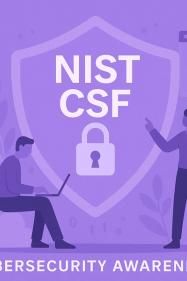The Family Educational Rights and Privacy Act (FERPA) protects the privacy of student education records in the United States. While FERPA places legal obligations on schools, universities, and education service providers, the biggest risk often lies with people, not systems.
From phishing scams targeting student information to accidental data leaks, human error is a leading cause of FERPA violations. That’s why a well-structured Cybersecurity Awareness Training (CSAT) program is vital — not only to comply with FERPA but to build a culture of data privacy in the education sector.
This article explores how CSAT supports FERPA compliance, what threats schools face, and how simulation-based training can reduce risk for students and institutions alike.
What Is FERPA?
FERPA, enacted in 1974, gives parents (and eligible students) rights regarding their education records. It applies to all educational agencies and institutions that receive federal funding from the U.S. Department of Education.
Key provisions include:
- The right to access records: Parents/students can inspect and review educational records.
- The right to request record corrections: Schools must correct inaccuracies or provide hearings.
- The right to privacy: Schools must obtain written consent before releasing personally identifiable information (PII), except under certain conditions.
FERPA requires schools to implement “reasonable methods” to protect records from unauthorized access — and that includes ensuring staff know how to handle data securely.
Why Employee Training Is Critical Under FERPA
FERPA doesn’t provide a technical checklist, but it requires institutions to control who has access to student records and how they handle that data. The Department of Education emphasizes that training staff is a critical part of ensuring compliance.
Human risks include:
- Staff responding to phishing attacks that compromise student accounts.
- Misdelivery of student information to the wrong recipient.
- Unauthorized disclosures due to lack of awareness about consent requirements.
- Falling for social engineering attacks that impersonate parents, students, or administrators.
An untrained workforce can easily violate FERPA — even unintentionally.
Cyber Threats Facing Educational Institutions
The education sector has become a prime target for cybercriminals. Common attacks include:
- Phishing emails disguised as financial aid updates or academic portals.
- Ransomware campaigns targeting school databases.
- Vishing scams requesting student records over the phone.
- Smishing through fraudulent text messages about grades or registration.
Training staff to spot and report these threats is critical to maintaining FERPA compliance and preventing data breaches.
How Cybersecurity Awareness Training Supports FERPA
CSAT addresses FERPA requirements by:
- Teaching employees how to handle student records safely.
- Educating staff on consent requirements and what counts as PII.
- Providing scenario-based learning to handle real-world attacks.
- Offering documentation and proof of training efforts during audits.
In essence, training serves as both a preventative and demonstrable control.
Simulation-Based Training for FERPA Compliance
Our platform delivers AI-powered simulations designed for education institutions, including:
Phishing Simulations
Emails impersonating student portals, learning management systems (LMS), or financial aid offices.
Smishing Simulations
Fake texts regarding grades, schedules, or account alerts.
Vishing Simulations
Calls pretending to be parents, education departments, or internal IT teams.
PII Handling Scenarios
Role-based exercises for teachers, administrators, and contractors.
We also offer custom content for higher education, where student data is often targeted for identity theft.
How Our Platform Helps Schools Stay Compliant
Key platform capabilities include:
- Training for all staff roles — from teachers to support staff and contractors.
- Audit-ready training logs to demonstrate compliance efforts.
- Interactive learning modules to improve policy awareness.
- Real-time analytics to monitor click rates, reporting behavior, and improvement.
We help schools and universities move beyond checkbox compliance to create a culture of privacy and security.
Best Practices for FERPA-Aligned Training Programs
To effectively meet FERPA requirements:
- Train All Staff, Not Just IT: Teachers, administrative assistants, and part-time staff all handle student data.
- Incorporate Realistic Threats: Simulations improve retention and behavioral change.
- Review Policies Regularly: Staff must understand when parental consent is required.
- Include Third-Party Vendors: FERPA applies to vendors with access to student records.
- Document Every Session: Keep detailed training logs for compliance and audits.
The Cost of FERPA Non-Compliance
FERPA violations can result in:
- Loss of federal funding.
- Legal action and financial settlements.
- Reputational damage for the institution.
- Student trust erosion, especially if sensitive data is leaked.
Training is one of the most affordable and effective safeguards against these risks.
Why Educational Institutions Choose Our Platform
We specialize in delivering CSAT programs tailored to education, offering:
- 🎯 FERPA-focused simulation templates
- 📊 Compliance dashboards for education IT and administrators
- 🧾 Audit-ready documentation
- 🌍 Support for multi-campus or remote learning environments
- 🔄 Continuous updates as privacy and cyber threats evolve
Conclusion: FERPA Compliance Starts with People
FERPA compliance isn’t just about policies — it’s about every individual who handles student data. Without proper training, even the most secure systems can be compromised by a single click or misstep.
By implementing simulation-based Cybersecurity Awareness Training, schools can meet FERPA requirements, reduce breach risks, and protect their students’ privacy.
Request a Demo
Learn how our AI-powered Awareness Training platform helps schools and universities meet FERPA obligations while strengthening staff cybersecurity awareness.

